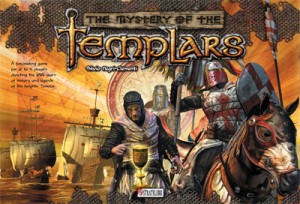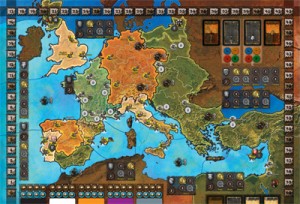Archive for the 'Essen Spiel 12' Category
Posted by James (admin) on 9th September 2013
I’m always interested in the history of the Knights Templar and I remember seeing a prototype of this game at Essen a few years ago. Players send their knights in missions so they can gain money and relics. A mission if successful if enough knights are sent and these can come from a mix of players, so there’s some possible collaboration.
Players can then buy and sell at the markets and events happen. After this, players can send their relics to different locations to put them on display; however, transporting anything takes money and is safer if escorted by knights. Of course, there are various enemies that may attack locations too, so players must allocate their knights and resources carefully.
Towards the end of the game, the persecution of the Knights Templar begins and players must try to rescue their relics and try to get them to their havens. When the persecution starts, players can only use money where it is currently located too (whereas, up until then, a player can move their money freely between their bases). The winner is the player with the most victory points scored during the game, plus points for relics, knights and cash in their havens when the game ends.
I love the setting and the game mechanics sound interesting too. I definitely want to try this one. More information and the rules can be found on Stratelibri’s Mystery of the Templars page: bga.me/templars
James.
Tags: board game news, Board Games, board gaming, Essen, Knights Templar, Mystery of the Templars, Spiel 13, Spiel 2013, Stratelibri
Posted in Board Games, Essen Spiel 12, Essen Spiel 13, Mystery of the Templars, On the Radar | No Comments »
Posted by James (admin) on 15th July 2013
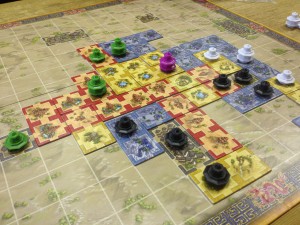
Note: The right-hand village should be owned by the white pagoda player as there are 3 white pagodas connected to it compared to 2 black pagodas.
Qin is a tile-laying game with a Chinese theme by Reiner Knizia. The winner is the first player to place all of their pagodas and players place pagodas on coloured territories they have created, so the game is about area control.
Players take turns placing 1 of the 3 tiles in their hand on the board next to any of the existing tiles. Each tile has 2 squares on it and each square can be red, yellow or blue. If a player creates a new contiguous territory of any single colour that consists of 2 squares or more, then they can claim that territory and place one of their pagodas on it. If a territory reaches 5 or more squares in size, then the owner adds a second pagoda to it.
If a tile joins two or more territories of the same colour together, then owner of the new large territory is the player who owned the most of the squares being combined. Territories of 5+ in size can never be merged.
Also on the board are some fixed black squares which are villages and these can be owned too. All the pagodas on territories that directly touch a village are added together – the player with the highest number places one of their pagodas on the village too. The pagoda on a village can change if the neighbouring territories change in a way to alter the totals and new clear winner emerges. Read the rest of this entry »
Tags: board game news, Board Games, board gaming, Knizia, Qin, Reiner Knizia
Posted in Board Game Review, Board Games, Essen Spiel 12, Qin | No Comments »
Posted by James (admin) on 11th July 2013
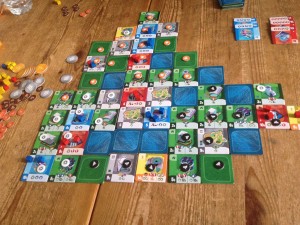
In City Tycoon, players are building different building tiles in the same city. The player with the most victory points (VPs) when the game ends after 4 rounds is the winner. The city starts with several fixed tiles in the middle including a small power and small water plant which are neutral.
Each of the 4 rounds is split into 3 main phases: Selecting tiles, Building/Selling tiles, and Activating tiles. The tile selecting phase starts with each player being dealt 6 building tiles – players look at them, keep 1 tile and pass the rest to the player on their left. This process happens 6 times with each player picking 1 tile from those they were passed, so each player ends with 6 tiles, as well as knowledge of what other tiles other players will have this round.
During the building/selling tiles phase, players take turns using 1 building tile from their hand in one of 3 ways:
- Build: The player pays the cost of the tile, places the tile in the city (next to any existing tile) and places a marker on it to show they own it. (Some buildings even generate cash, VPs, etc. when they are built too.)
- Sell: The player discards the tile and receives $5.
- Plant: The player discards the tile and can build the next available power or water generating plant tile (paying the cost marked on the plant tile and placing a marker on it to show they own it).
Finally, players take turns activating one of the building tiles they own to gain the benefit shown on the tile. Read the rest of this entry »
Tags: board game news, Board Games, board gaming, City Tycoon, Essen, Rebel.pl, Spiel 2012
Posted in Board Game Review, Board Games, City Tycoon, Essen Spiel 12 | No Comments »
Posted by James (admin) on 31st May 2013
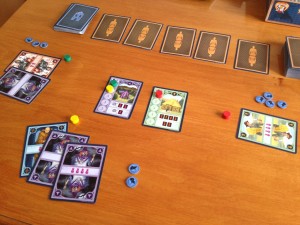 Rattus Cartus is a card game set in the world of medieval plague as is its sibling game, Rattus. It should make it clear that Rattus Cartus is not a card game version of the original Rattus game as, whilst is uses the same theme and art style, it has its own game mechanics.
Rattus Cartus is a card game set in the world of medieval plague as is its sibling game, Rattus. It should make it clear that Rattus Cartus is not a card game version of the original Rattus game as, whilst is uses the same theme and art style, it has its own game mechanics.
The goal is to earn the most victory points (VPs). At the end of the game, players score VPs based on how much influence they have with each of the 6 different character classes (10 VPs for having the most, 5Vps for 2nd most, and 2 VPs for third most influence). Some other VPs can be earned during the game too.
The game primarily comprises of character cards (6 types) and building cards (6 types each corresponding to a character). During set-up 5 random character cards are laid out face-down – each card has 0-4 nuns on it – and these are called the ‘nun’ cards. At the end of the game, any player who has more rats than the total number of nuns on these 5 cards is lost to the plague and automatically loses. Read the rest of this entry »
Tags: board game news, Board Games, board gaming, Essen, Rattus Cartus, Spiel 2012, White Goblin Games
Posted in Board Game Review, Board Games, Essen Spiel 12, Rattus Cartus | No Comments »
Posted by James (admin) on 3rd December 2012
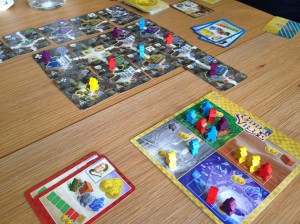
Oddville is a eurogame with a city building theme and a very compact game design. By that, I don’t mean its physical playing-size on the table; instead, I mean that the game mechanics are neatly compressed. As a result, Oddville contains a clever, inventive design with more game than you may expect from a relatively short game.
During the game player’s gain resources, money and characters as well as construct buildings so they can score the most victory points (VPs). The game ends as soon as any player places their 6th worker in the city.
Each player has their own deck of 4 action cards. On their turn, a player can play 1 action card which allows them to either gain the cash shown, or gain 1 of the resources shown, or gain 1 building from the 6 building cards on display (the card affects the price). The cards range from strong to weak and the player gets these cards back once they have used all 4, or they can spend cash to get all used ones back (but the more cards still hand, the greater the cost).
When a player chooses to gain one of the resources on their action card, they place one of their workers on the lowest market price for that resource (which are limited in number) and pays the price. The worker on the board shows the player has that resource until they spend it when building. The game scales with 2 players as there are fewer cheap resources available. Read the rest of this entry »
Tags: board game news, Board Games, board gaming, Essen, Oddville, Spiel 2012
Posted in Board Game Review, Board Games, Essen Spiel 12, Oddville | 3 Comments »
Posted by James (admin) on 22nd November 2012
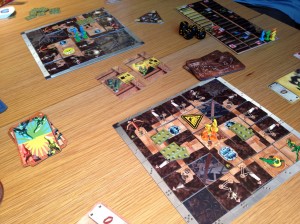 In Goblins Inc, players are goblins creating giant war robots that will fight each other. First, players are placed in random teams – these teams will change after the first fight and new robots are built by these new teams for the second (final) fight. The players who build a robot that wins a fight score victory points (VPs), plus players get individual VPs for their own hidden agenda cards. Before any building takes place, players draw 7 cards from their hidden agenda deck – just before the fight, players will choose just 4 of their 7 cards which will score them VPs once the fight is over. Hidden agenda cards award VPs based on (a) destroying specific types of tiles on the opponent’s robot, or (b) specific types of tiles not being blown off of your own robot), or (c) predicting which side will win. (Yes, you can predict the opponent to win and help it happen too). The player with the most VPs after two fights is the winner.
In Goblins Inc, players are goblins creating giant war robots that will fight each other. First, players are placed in random teams – these teams will change after the first fight and new robots are built by these new teams for the second (final) fight. The players who build a robot that wins a fight score victory points (VPs), plus players get individual VPs for their own hidden agenda cards. Before any building takes place, players draw 7 cards from their hidden agenda deck – just before the fight, players will choose just 4 of their 7 cards which will score them VPs once the fight is over. Hidden agenda cards award VPs based on (a) destroying specific types of tiles on the opponent’s robot, or (b) specific types of tiles not being blown off of your own robot), or (c) predicting which side will win. (Yes, you can predict the opponent to win and help it happen too). The player with the most VPs after two fights is the winner.
For each robot fight, players first need to build their robot by adding 20 tiles to their 5×5 grid – the centre space is always the cockpit and 4 spaces (determined by a card each fight) must remain empty. Tiles show engines, weapons, decorations and armour, plus they also show the underlying bodywork too. When building, you can place tiles on any empty grid space; however, if any tile is not contiguously connected by bodywork before the fight starts then it will fall off. Read the rest of this entry »
Tags: board game news, Board Games, board gaming, Essen, Goblins, Spiel 2012
Posted in Board Game Review, Board Games, Essen Spiel 12, Goblins | No Comments »
Posted by James (admin) on 20th November 2012
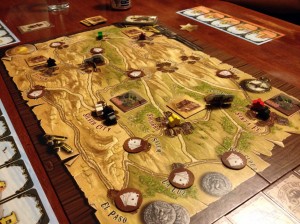 In Desperados, one player is the marshal trying to protect the Wild West from the other players who are all outlaws working together to rob banks, fix poker games and hold-up stage coaches. If the outlaws can gather a total of $4,000 for each outlaw player after 5 rounds, the outlaws win.
In Desperados, one player is the marshal trying to protect the Wild West from the other players who are all outlaws working together to rob banks, fix poker games and hold-up stage coaches. If the outlaws can gather a total of $4,000 for each outlaw player after 5 rounds, the outlaws win.
The gameplay uses an interesting hidden-movement game mechanic as the outlaws try to move to where the sheriffs and marshal are not located so they can steal money and avoid being arrested. (I’ll explain the game mechanic in a bit of detail as it’s the core of the game – it’s actually simple but requires careful explanation.)
GAMEPLAY
The board shows various towns and cities connected by roads – towns have poker game tiles (worth $300-$600), cities have bank tiles (worth $500-$3,200), and stagecoaches move to towns and cities along pre-determined routes (worth $800-$1,200 when robbed). Note that the tiles are random and values hidden so outlaws don’t know exactly what they’re worth.
Wooden figures on the board (meeple) show the locations of each outlaw, the marshal and the sheriffs (1 sheriff per outlaw player). Each outlaw and marshal player has a deck of cards: 1 card showing each town/city plus 1 saloon card. Each of the 5 rounds is split into a planning phase followed by an evaluation phase. Read the rest of this entry »
Tags: board game news, Board Games, board gaming, Desperados, Essen, Spiel 2012
Posted in Board Game Review, Board Games, Desperados, Essen Spiel 12 | 2 Comments »
Posted by James (admin) on 16th November 2012
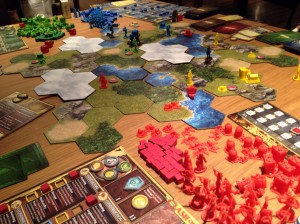
A player board can be seen at the bottom of the picture. Notice the cubes in the square holes marking the advances gained.
Clash of Cultures is a civilisation building game by the designer of Merchants and Marauders and this sole fact meant it was on my ‘must play’ list as Merchants & Marauders was a superb game. In Clash of Cultures, players start as rival tribes in corners of the realm with no technology. Over 6 rounds, the players explore the land, generate resources, build cities, create technologies, trade, potentially fight each other, and do whatever they can to be the most successful. At the end of the game, victory points (VPs) are scored for building cities (1VP per piece), advances in technology (1/2VP each), completing objective cards (2VP each) and building wonders (5VP each) – the player with the most VPs wins.
GAME
The board/map is made of tiles (each showing 4 hexes) of various types: water, mountains, barren, grassland, forest. Unexplored regions remain face-down until entered when a player turns the tile over and sometimes gets a choice on its orientation.
Players all start the same with 1 settler, the Farming and Mining advances and 1 basic city. During the game, cities can be improved by adding a port, academy, temple and/or fortress. The size of a city is equal to the total number of pieces – the bigger the size, the more resources it collects and influence it has; however, city size is limited by the number of cities you own so you can’t just have one super-city. A city that is happy functions like a city of 1 larger size; whereas, an angry city functions like a city of size 1. Read the rest of this entry »
Tags: board game news, Board Games, board gaming, Clash of Cultures, Essen, Spiel 2012, Z-Man Games
Posted in Board Game Review, Board Games, Clash of Cultures, Essen Spiel 12 | No Comments »
Posted by James (admin) on 13th November 2012
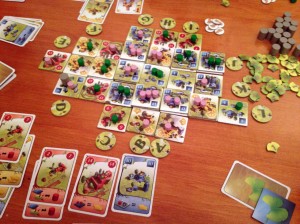
Ginkgopolis is by one of the designers I really like – Xavier Georges (Carson City, Royal Palace, Troyes and Tournay). Ginkgopolis is a game with the theme of futuristic, city building. As with many of Georges’ games, the game mechanic is a bit unusual (it’s actually relatively simple, although it may not seem so at first). As a result, I felt it important to explain the gameplay quite clearly (so please excuse the length of this review) because a brief outline would offer little insight.
GAME
At the start of the game, there are 9 building tiles in a 3×3 grid – 3 red, 3 yellow and 3 blue buildings with values 1, 2 and 3 – surrounded by lettered discs A-L. The initial card deck contains cards for each letter and each of the 9 starting buildings. Players start with some resources (cubes) of their own colour and some building tiles. During the game, the players will add building tiles to the 3×3 grid (on the outside as well as laying new tiles on top of existing ones). Players score victory points (VPs) when placing some tiles, and at game end for controlling areas plus bonus VPs based on cards they own. The player with the most VPs at the end of the game wins. Read the rest of this entry »
Tags: board game news, Board Games, board gaming, Essen, Ginkgopolis, Pearl Games, Spiel 2012, Xavier Georges, Z-Man Games
Posted in Board Game Review, Board Games, Essen Spiel 12, Ginkgopolis | No Comments »
Posted by James (admin) on 6th November 2012
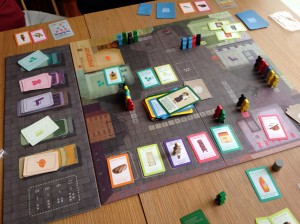 When someone suggests a game about queuing and shortages in Poland in the 1980’s, your first thought is probably to avoid eye contact and back away. However, Kolejka (which is Polish for ‘Queue’ and pronounced col-aay-ka) is actually a gem of a game which I hope gets the attention it deserves as it actually contains a great Eurogame as well as an interesting and fitting theme.
When someone suggests a game about queuing and shortages in Poland in the 1980’s, your first thought is probably to avoid eye contact and back away. However, Kolejka (which is Polish for ‘Queue’ and pronounced col-aay-ka) is actually a gem of a game which I hope gets the attention it deserves as it actually contains a great Eurogame as well as an interesting and fitting theme.
Players are each trying to obtain 10 goods listed on their objective cards – for example, 4 luxury goods, 3 pieces of clothing, 2 food and 1 electrical. The first player to collect all of their items wins, or the player that collects the most of their items by the end of the game.
Each round a few goods will arrive at some of the 5 stores. First, before knowing what will arrive where, players take turns adding any of their people (meeple) who are not in queues to the queues. Then, goods cards are revealed which determine how many goods arrive at which stores, e.g. 2 electrical items at the electrical store, 3 foods at the food store, etc. Read the rest of this entry »
Tags: board game news, Board Games, board gaming, Essen, Kolejka, Poland, Queue, Rebel.pl, Spiel 2012
Posted in Board Game Review, Board Games, Essen Spiel 12, Kolejka (Queue) | No Comments »
